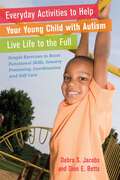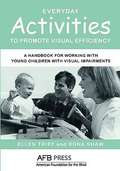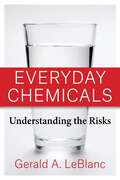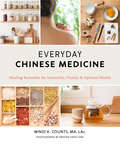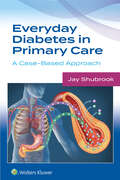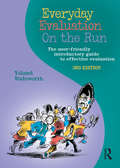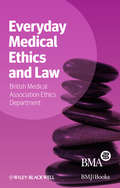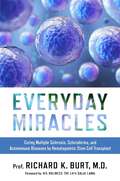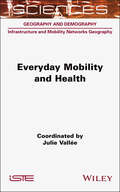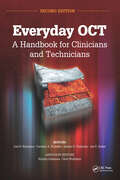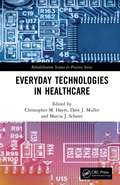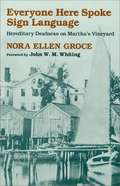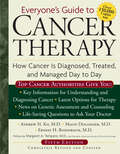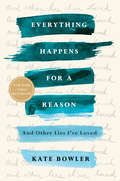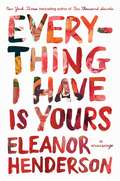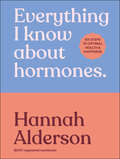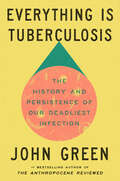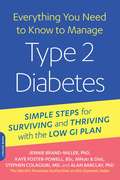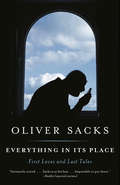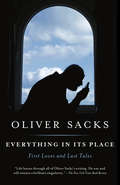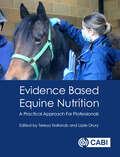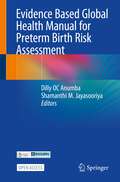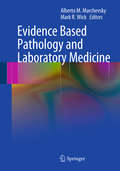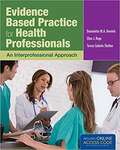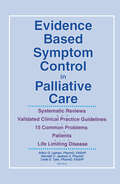- Table View
- List View
Everyday Activities to Help Your Young Child with Autism Live Life to the Full
by Debra S. Jacobs Dion E. BettsDoes your child struggle with brushing their teeth? Is it difficult to get them dressed and undressed each day? Do they struggle to understand their body's relationship to the world?This book is brimming with simple ideas, activities and exercises to address these daily challenges that young children with autism face. Easy to carry out and to fit into your routines, they will help improve a child's sense of body awareness, coordination and motor skills, and address key tasks such as eating meals and healthy sleep. There are also ideas for tackling social challenges, including playing with friends, going on holiday and staying calm at school. The final chapter of the book explains the different support professionals parents of a child with autism are likely to encounter and how each can help their child. This jargon-free book shows how occupational therapy techniques can be used to help your young child with autism to live life to the full, and will be an essential tool for parents and carers.
Everyday Activities to Promote Visual Efficiency: A Handbook for Working with Young Children with Visual Impairments
by Rona Shaw Ellen TriefEarly intervention services are essential for infants and toddlers who are visually impaired and have some functional vision that they will be able to use for everyday activities--not only to ensure their early development but also to help them learn to use their vision with maximum effectiveness, right from the start. Everyday Activities to Promote Visual Efficiency offers guiding principles for early intervention with very young children who are visually impaired and who may also have additional disabilities. This important new resource provides simple activities that can be incorporated easily by families and service providers into the everyday routines of a baby or child to facilitate early visual development and use of functional vision.
Everyday Chemicals: Understanding the Risks
by Gerald A. LeBlancWhat is the likelihood that common chemicals such as bisphenol-A, which is found in plastic water bottles, are harming us? Should shoppers be concerned about pesticide residues on fruits and vegetables in the supermarket produce aisle? Are we risking adverse health effects when we use insect repellent that contains DEET or slather on sunscreen? Modern life requires us to navigate an endless sea of chemicals. How do we know whether we need to worry about them?This book is a layperson’s guide to understanding chemical risk. The toxicologist Gerald A. LeBlanc offers a nontechnical overview of the key factors in evaluating whether exposure to chemicals in our daily lives could be harmful. He leads readers through the basic concepts of risk assessment using real-world examples. LeBlanc emphasizes that chemical hazard depends on the level of exposure and provides practical strategies for sensible decision making. The book features a series of accessible case studies describing how we all can reach rational conclusions about the danger of typical chemical exposures we experience every day.Giving nonexpert readers the tools to understand chemical risks, this book shows how critical thinking and science literacy can help us live with less fear and anxiety and make reasonable choices when confronted with potential hazards.
Everyday Chinese Medicine: Healing Remedies for Immunity, Vitality, and Optimal Health
by Mindi K. CountsAchieve vibrant health in every season with the holistic techniques of traditional Chinese medicine.This friendly guide to a 2,000-year-old lineage of healing wisdom integrates both the Five Element theory and the practices of traditional Chinese medicine to uncover what your body needs for balance and optimal health. Everyday Chinese Medicine demystifies, simplifies, and reveals patterns to help you take control of your own well-being from the comfort of your own home and kitchen. Mindi Counts—a holistic medical practitioner, acupuncturist, and herbalist—walks you through the seasons, elements, and organ systems to help you understand your unique constitution and how to achieve energetic and physical balance. With simple recipes, self-care practices, and time-tested herbal remedies, Everyday Chinese Medicine is the perfect companion on your path to complete wellness.
Everyday Diabetes in Primary Care: A Case-Based Approach
by Jay ShubrookMore than 85% of people with diabetes receive their diabetes care in the primary care setting. With the busy primary care practitioner in mind, Everyday Diabetes in Primary Care: A Case-Based Approach offers dozens of diabetes cases in an easy-to-digest format—each representing a common clinical question that clinicians face in this common and complex area. For every case, fellowship-trained diabetologist Dr. Jay Shubrook shares his considerable expertise, providing authoritative, real-world guidance for your day-to-day management of patients with diabetes.
Everyday Evaluation on the Run: The user-friendly introductory guide to effective evaluation
by Yoland Wadsworth'Practical, useful counsel emanates throughout. Impressively grounded in real world experiences.' - Michael Quinn Patton, author of Utilisation-Focused EvaluationEffective evaluation can provide valuable insights into the way a program, a course or an organisation is being run, and direction for improvement. This widely-used introduction to evaluation is intended for non-specialists in the human services who need to do evaluation as part of a busy workload.Everyday Evaluation on the Run offers a practical over view of the main approaches to evaluation, strategies for involving stakeholders, and the evaluation industry's toolbox of models and techniques. The author emphasises the core principles and concepts of evaluation, and the idea of building a culture of evaluation.This third edition of Everyday Evaluation on the Run reflects current thinking on values in organisations and the need to use evaluation to guide future practice rather than just as an auditing process. With extensive examples, it is a handy reference for professionals and students in health, welfare, and community work, and in government and non-profit agencies.
Everyday Medical Ethics and Law
by BMA Medical Ethics DepartmentEveryday Medical Ethics and Law is based on the core chapters of Medical Ethics Today, focussing on the practical issues and dilemmas common to all doctors. It includes chapters on the law and professional guidance relating to consent, treating people who lack capacity, treating children and young people, confidentiality and health records. The title is UK-wide, covering the law and guidance in each of the four nations. Each chapter has a uniform structure which makes it ideal for use in learning and teaching. "10 Things You Need to Know About..." introduces the key points of the topic, Setting the Scene explains where the issues occur in real life and why doctors need to understand them, and then key definitions are followed by explanations of different scenarios. The book uses real cases to illustrate points and summary boxes to highlight key issues throughout. Whilst maintaining its rigorous attention to detail, Everyday Medical Ethics and Law is an easy read reference book for busy, practising doctors.
Everyday Miracles: Curing Multiple Sclerosis, Scleroderma, and Autoimmune Diseases by Hematopoietic Stem Cell Transplant
by Dr. Richard BurtA life-changing treatment is conquering auto-immune disorders—why doesn&’t anyone know about it? Thirty-five years ago, Dr. Richard Burt began a journey to treat chronic autoimmune diseases as they&’d never been treated before. Using a treatment originally developed for leukemia but modified to be more gentle—a one-time combination of immune targeting drugs followed by a transplant of the patient&’s blood stem cells—he has documented the successful and often dramatic reversal of multiple sclerosis, systemic sclerosis (scleroderma), chronic inflammatory demyelinating polyradiculoneuropathy (CIPD), neuromyelitis optica, and Crohn&’s disease. After decades of study and randomized trials, his approach, which has been duplicated in other parts of the world, is finally being recognized as an effective means of reversing these &“incurable&” diseases. Some of his patients have been symptom-free for more than twenty years, and in this book Dr. Burt tells their stories alongside his own journey of developing and refining the treatment, known as hematopoietic stem cell transplant (HSCT) for autoimmune disorders. &“These patients are the heroes,&” Dr. Burt has said. &“Their bodies and spirits faced unrelenting disease, and yet they fight valiantly against the suffering and obstacles.&” What is HSCT? How does it work? What are the risks? Why aren&’t more doctors talking about it? And why is it still out of reach for so many patients who could benefit from it? Dr. Burt answers these questions and many more. Written for the layperson, Everyday Miracles grants patients with autoimmune diseases and the people who love them insights into the revolutionary approach that could convert their life sentence into a one-time reversible illness.
Everyday Mobility and Health (ISTE Consignment)
by Julie ValléeEveryday mobility is neither favorable nor unfavorable to health. While it can facilitate social interactions, increase access to remote services, or encourage physical activity, it can also generate pollution, promote the spread of epidemics or cause traffic accidents. This book presents different facets of the relationship between daily mobility and health, focusing on the environments (geographical, social and political) that people live and move around in. It analyzes the role of mobility in the mechanisms of environmental exposure and diffusion, as well as the resulting health inequalities. It deals with active modes of travel (mainly walking and cycling) and the local contexts that are conducive to them. Finally, it offers a critical reading of the place given to everyday mobility in policies to combat obesity and rationalize regional healthcare provision.
Everyday OCT: A Handbook for Clinicians and Technicians
by James G. Fujimoto Joel S. Schuman Jay Duker Carmen A. PuliafitoOptical coherence tomography has become a part of clinical routine in everyday eye practice, allowing objective, quantitative structural assessment and driving clinical decision making in retinal diseases, glaucoma and cataract surgery. To guide the eyecare professionals who rely on this technology, Everyday OCT: A Handbook for Clinicians and Technicians, Second Edition is a user-friendly, practical reference that provides all of the information they need to know about current OCT technologies and their clinical utilities. Drs. Joel S. Schuman, Carmen A. Puliafito, James G. Fujimoto, and Jay S. Duker represent the cutting edge of OCT applications and, together with their expert contributing authors, they have created a clear and concise guide designed to provide clinicians and technicians with the knowledge and tips to best utilize OCT technology. This Second Edition is split into three parts: an operational guide with in-depth guidance and tips on the six major OCT devices from six different manufacturers, an interpretation guide featuring all the major pathologies OCT can visualize, and a technical guide containing detailed technical aspects of the SD-OCT and the future of OCT technologies.Everyday OCT, Second Edition explains how to: Set up and employ OCT technology Select and facilitate scans Ensure and assess the quality of scans Accurately interpret OCT images Everyday OCT: A Handbook for Clinicians and Technicians, Second Edition covers the diversity of new devices and applications in the field of OCT in a succinct and easy-to-read format, making it the ideal resource for clinicians and technicians to have by their side when performing or interpreting OCTs.
Everyday Technologies in Healthcare (Rehabilitation Science in Practice Series)
by Marcia Scherer Christopher M. Hayre Dave MullerThis book examines the role of everyday technology throughout the life cycle in order to demonstrate the wide acceptance and impact of everyday technology and how it is facilitating both practitioners and patients in contemporary practices. In response, then, this text speaks to a number of audiences. Students writing for undergraduate and postgraduate dissertations/proposals will find the array of works insightful, supported with a vast number of references signposting to key texts. For academics, practitioners and prospective researchers this text offers key empirical and methodological insight that can help focus and uncover originality in their own field. We anticipate that readers will find the collection of empirical examples useful for informing their own work, but also, it attempts to ignite new discussions and arguments regarding the application and use of everyday technology for enhancing health internationally. Explores the multifaceted use and application of each ‘everyday technology’ that impact on diagnosis, treatment and management of individuals. Examines an array of everyday technologies and how these that can either enhance and/or hinder patient/service user outcomes i.e. handheld devices, computer workstations, gamification and artificial intelligence. Discusses technologies that are intended to facilitate patient diagnosis, practitioner-patient relations, within an array of health contexts. Provides readers with an overview with future direction of everyday technologies and its limitations.
Everyone Here Spoke Sign Language: Hereditary Deafness on Martha's Vineyard
by Nora E. Groce<P>From the seventeenth century to the early years of the twentieth, the population of Martha's Vineyard manifested an extremely high rate of profound hereditary deafness. <P>In stark contrast to the experience of most deaf people in our own society, the Vineyarders who were born deaf were so thoroughly integrated into the daily life of the community that they were not seen-- and did not see themselves-- as handicapped or as a group apart. Deaf people were included in all aspects of life, such as town politics, jobs, church affairs, and social life. <P>How was this possible? On the Vineyard, hearing and deaf islanders alike grew up speaking sign language. This unique sociolinguistic adaptation meant that the usual barriers to communication between the hearing and the deaf, which so isolate many deaf people today, did not exist.
Everyone's Guide to Cancer Therapy: How Cancer Is Diagnosed, Treated, and Managed Day to Day
by Andrew Ko Malin Dollinger Ernest H. Rosenbaum&“Written by two oncologists . . . this authoritative but readable reference stands out . . . as a uniquely comprehensive, thorough source of up-to-date information&” (Library Journal). For more than thirty years, Everyone&’s Guide to Cancer Therapy has been the definitive resource for anyone confronting a cancer diagnosis. The revised and updated fifth edition draws on the latest research, information, and advice from more than 100 top oncology specialists. Equally informative and accessible, this comprehensive book helps cancer patients and their caregivers navigate through diagnosis, treatment, and supportive care. Topics include: * Information on recently approved targeted therapies for various cancer types * The newest strategies in cancer diagnosis and prevention * Cancer biology: translating scientific discoveries into meaningful advances for patients * Supportive care and complementary approaches
Everything Happens for a Reason: And Other Lies I've Loved
by Kate Bowler<P>Kate Bowler is a professor at Duke Divinity School with a modest Christian upbringing, but she specializes in the study of the prosperity gospel, a creed that sees fortune as a blessing from God and misfortune as a mark of God’s disapproval. <P>At thirty-five, everything in her life seems to point toward “blessing.” She is thriving in her job, married to her high school sweetheart, and loves life with her newborn son. Then she is diagnosed with stage IV colon cancer. <P>The prospect of her own mortality forces Kate to realize that she has been tacitly subscribing to the prosperity gospel, living with the conviction that she can control the shape of her life with “a surge of determination.” Even as this type of Christianity celebrates the American can-do spirit, it implies that if you “can’t do” and succumb to illness or misfortune, you are a failure. <P>Kate is very sick, and no amount of positive thinking will shrink her tumors. What does it mean to die, she wonders, in a society that insists everything happens for a reason? Kate is stripped of this certainty only to discover that without it, life is hard but beautiful in a way it never has been before. Frank and funny, dark and wise, Kate Bowler pulls the reader deeply into her life in an account she populates affectionately with a colorful, often hilarious retinue of friends, mega-church preachers, relatives, and doctors. <P>Everything Happens for a Reason tells her story, offering up her irreverent, hard-won observations on dying and the ways it has taught her to live. <P><b>A New York Times Bestseller</b>
Everything I Have Is Yours: A Marriage
by Eleanor HendersonA NEW YORK TIMES NOTABLE BOOK OF THE YEAR • From New York Times bestselling author Eleanor Henderson comes a turbulent love story meets harrowing medical mystery: the true story of the author’s twenty-year marriage defined by her husband’s chronic illness—and a testament to the endurance of love Eleanor met Aaron when she was just a teenager and he was working at a local record stored—older, experienced, and irresistibly charming. Escaping the clichés of fleeting young love, their summer romance bloomed into a relationship that survived college and culminated in a marriage and two children. From the outside looking in, their life had all the trappings of what most would consider a success story.But, as in any marriage, things weren’t always as they seemed. On top of the typical stresses of parenting, money, and work, there were the untended wounds of depression, addiction, and childhood trauma. And then one day, out of nowhere: a rash appeared on Aaron’s arms. Soon, it had morphed into painful lesions covering his body. Eleanor was as baffled as the doctors. There was no obvious diagnosis, let alone a cure. And as years passed and the lesions gave way to Aaron’s increasingly disturbed concerns about the source of his sickness, the husband she loved seemed to unravel before her eyes. A new fissure ruptured in their marriage, and new questions piled onto old ones: Where does physical illness end and mental illness begin? Where does one person end and another begin? And how do we exist alongside someone else’s suffering?Emotional, intimate, and at times agonizing, Everything I Have Is Yours tells the story of a marriage tested by powerful forces outside both partners’ control. It’s not only a memoir of a wife’s tireless quest to heal her husband, but also one that asks just what it means to accept someone as they are.
Everything I Know About Hormones: Six Steps to Optimal Health and Happiness
by Hannah AldersonFor too long, women have been led to believe that hormones are our enemies. With concerns brushed off by doctors, we find ourselves struggling with our hormones, and blaming them for bloating, stress, tiredness and so much more. But what if they aren’t the problem? Your hormones are your superpower – only, they can’t thrive without your help. Founder of the Positive Method, Hannah Alderson, will show you just how simple that can be. Driven by her own health obstacles, Alderson has collaborated closely with world-leading scientists to research our hormones and discovered how to build an ecosystem that works. Learn why creating a happier hormone habitat is about diet, balance, movement, sleep, honesty and choices. And take action: from taming triggers to optimizing hormones, Alderson’s six-pillar approach and evidence-based hacks open the door to a world of positive change. Whether you seek renewed energy, quality sleep or sharper focus, address underlying problems and find your happy today.
Everything Is Tuberculosis: The History and Persistence of Our Deadliest Infection
by John GreenJohn Green, the #1 bestselling author of The Anthropocene Reviewed and a passionate advocate for global healthcare reform, tells a deeply human story illuminating the fight against the world’s deadliest infectious disease. <p> “This highly readable call to action could not be more timely.” –Kirkus, starred review. <p> “Memorably probes the intersections of medicine and human emotion.” –Bookpage, starred review. <p> Tuberculosis has been entwined with humanity for millennia. Once romanticized as a malady of poets, today tuberculosis is seen as a disease of poverty that walks the trails of injustice and inequity we blazed for it. In 2019, author John Green met Henry Reider, a young tuberculosis patient at Lakka Government Hospital in Sierra Leone. John became fast friends with Henry, a boy with spindly legs and a big, goofy smile. In the years since that first visit to Lakka, Green has become a vocal advocate for increased access to treatment and wider awareness of the healthcare inequities that allow this curable, preventable infectious disease to also be the deadliest, killing over a million people every year. <p> In Everything Is Tuberculosis, John tells Henry’s story, woven through with the scientific and social histories of how tuberculosis has shaped our world—and how our choices will shape the future of tuberculosis. <b>New York Times Bestseller</b>
Everything You Need to Know to Manage Type 2 Diabetes: Simple Steps for Surviving and Thriving with the Low GI Plan
by Kaye Foster-Powell Jennie Brand-Miller Stephen Colagiuri Alan BarclayA practical, easy-to-use guide to help you manage type 2 diabetes or prediabetes If you are one of the millions of people living with diabetes or prediabetes, you may feel like you're inundated with information on how to manage your condition. The good news is that we now know a lot more about managing diabetes or reducing your risk of developing it--and here, the world's foremost glycemic index experts share their wisdom. Rather than blind you with science or swamp you with facts, Everything You Need to Know to Manage Type 2 Diabetes sets out clearly and simply what you need to eat and do to help you: Reduce your risk of developing diabetes Improve your insulin sensitivity and your cardiovascular health Keep your blood glucose levels, blood pressure, and blood fats under control Reduce your body fat and maintain a healthy body With tips and strategies for working with your doctor, the most recent info on medications, and guidance on the best foods to eat (at home or at a restaurant), Everything You Need to Know to Manage Type 2 Diabetes offers uncomplicated, straightforward advice to help you survive--and thrive.
Everything in Its Place: First Loves and Last Tales
by Oliver SacksFrom the bestselling author of Gratitude and On the Move, a final volume of essays that showcases Sacks's broad range of interests--from his passions for ferns, swimming, and horsetails, to his final case histories exploring schizophrenia, dementia, and Alzheimer's.Oliver Sacks, renowned scientist and storyteller, is adored by readers for his neurological case histories, his fascination and familiarity with human behaviour at its most unexpected and unfamiliar. Everything in Its Place is a celebration of Sacks's myriad interests, all told with his characteristic compassion, erudition, and luminous prose. From the celebrated case history of Spalding Gray that appeared in The New Yorker four months before his death to reflections on mental asylums; from piercing accounts of Schizophrenia to a reminiscence of Robin Williams; from the riveting tale of a medical colleague falling victim to Alzheimer's to the cinematography of Michael Powell, this volume celebrates and reflects the wondrous curiosity of Oliver Sacks.
Everything in Its Place: First Loves and Last Tales
by Oliver SacksFrom the legendary author of The Man Who Mistook His Wife for a Hat: a volume of essays on everything from primordial life and the mysteries of the brain to the ancient ginkgo and the power of the written word. "Magical . . . [Everything in Its Place] showcases the neurologist's infinitely curious mind."—People MagazineIn this volume, Oliver Sacks examines the many passions that defined his life--both as a doctor engaged with the central questions of human existence and as a polymath conversant in all the sciences. Everything in Its Place brings together writings on a rich variety of topics. Why do humans need gardens? How, and when, does a physician tell his patient she has Alzheimer's? What is social media doing to our brains? In several of the compassionate case histories included here, we see Sacks consider the enigmas of depression, psychosis, and schizophrenia for the first time. In others, he returns to conditions that have long fascinated him: Tourette's syndrome, aging, dementia, and hallucinations. In counterpoint to these elegant investigations of what makes us human, this volume also includes pieces that celebrate Sacks's love of the natural world--and his final meditations on life in the twenty-first century.
Evidence Based Equine Nutrition: A Practical Approach For Professionals
by Louise Jones Nikki Bell Rod Fisher Faith Burden Bryony WitherowThis book uniquely provides both the scientific basis of equine nutrition and the translation of that science into practical, day-to-day feeding advice. It summarises the latest research to provide readers with the evidence base needed to both confidently advise those who want to understand the science behind equine nutrition, and apply that evidence into practical advice for anyone who just wants to know how to feed horses. Both veterinary and animal science courses struggle to provide adequate nutrition training within their syllabuses. Much of the general information available is poorly explained and not evidence based. This book fills that gap, with the author team relaying over 50 cumulative years' experience teaching equine nutrition to both practising clinicians and students. Find answers to the most common queries and challenges encountered during nutritional consultations across 17 informative chapters, using typical case-based examples as experienced by the authors. Fully supported throughout with visual aids and photographic illustrations, they show how to easily increase compliance and understanding. Key topics covered include: How to take a diet history, including which forage and concentrates are most appropriate, and how to interpret the information on feed labels; How to take the horse's history, including workload, body weight and body fat scoring; Supporting achievable and sustainable fat loss in overweight horses; Appropriate rations across a range of performance disciplines and for breeding horses; Appropriate feeds and supplements for competition, including how to recognise potential hazards, signs of quality and issues of feed safety; How to use ration programmes, including a range of frequently asked questions for horses with specific nutritional requirements from allergies to obesity. A recommended resource to support the teaching of veterinary nutrition, this book should also be found on the bookshelf of all veterinarians, animal scientists, trainers, nutritionists, and nutritional advisors. This book includes forewords by Carl Lester, Honorary Fellow of the British Horse Society and recipient of an MBE for his services to Equestrianism, and Tim Mair, former President of the British Equine Veterinary Association.
Evidence Based Global Health Manual for Preterm Birth Risk Assessment
by Dilly Oc Anumba Shamanthi M. JayasooriyaThis is an open access book. In this open access book the NIHR Global Health research group on preterm birth, PRIME, prioritizes the development of prenatal risk assessment guidance for preterm birth. This book is based on global literature, published international, national and regional guidance and it is structured into six chapters providing: an overview of the domains for risk assessment and the summary recommendations in greater depth maternal demographics and past pregnancy histories, accurate pregnancy dating, and the contribution of infection, nutritional status and substance misuse to preterm birth risk. Each chapter has structured sections which include a) background information, b) an evidence statement highlighting the risk factors covered, and c) practical recommendations for evaluating those risks as well as the evidenced recommended and effective interventions for women deemed to be at risk. The chapter ends with clinical and research recommendations regarding factors of unknown or unproven risk (“myth busters”). This open access book will be a very useful guide for all health care professionals involved in delivering pregnancy care.
Evidence Based Pathology and Laboratory Medicine
by Mark Wick Alberto M. MarchevskyFocusing on practical, patient related issues, this volume provides the basic concepts of Evidence Based Medicine (EBM) as they relate to Pathology and Laboratory Medicine and presents various practical applications. It includes EBM concepts for use in the identification of cost-effective panels of immunostains and other laboratory tests and for improvement of diagnostic accuracy based on the identification of selected diagnostic features for particular differential diagnosis. EBM concepts are also put forth for use in Meta-analysis to integrate the results of conflicting literature reports and use of novel analytical tools such as Bayesian belief networks, neural networks, multivariate statistics and decision tree analysis for the development of new diagnostic and prognostic models for the evaluation of patients. This volume will be of great value to pathologists who will benefit from the concepts being promoted by EBM, such as levels of evidence, use of Bayesian statistics to develop diagnostic and other rules and stronger reliance on "hard data" to support therapeutic and diagnostic modalities.
Evidence Based Practice for Health Professionals
by Bernadette Howlett Ellen RogoEvidence Based Practice for Health Professionals is included in the 2015 edition of the essential collection of Doody’s Core Titles. Evidence based practice (EBP) has become the standard in health care practice today. Evidence Based Practice for Health Professionals covers the fundamentals of applying medical evidence to clinical practice and discussing research findings with patients and fellow professionals. This essential text explains the basic concepts of EBP, its applications in health care, and how to interpret biostatistics and biomedical research. With examples derived from multiple health professions, Evidence Based Practice for Health Professionals teaches the skills needed to access and interpret research in order to successfully apply it to collaborative, patient-centered health care decisions. Students gain valuable practice with skill-building learning activities, such as explaining the evidence for treatments to patients, developing a standard of care, selecting a diagnostic tool, and designing community-based educational materials. Evidence-Based Practice for Health Professionals also helps prepare students to communicate knowledgeably with members of interprofessional healthcare teams as well as with pharmaceutical sales representatives. <P><P> • Covers EBP fundamentals and their application to clinical practice • Teaches the skills needed to interpret medical research and apply it to patient care • Enables students to develop EBP skills with practical learning activities • Prepares students to communicate about medical evidence with patients and fellow professionals INSTRUCTOR RESOURCES • Instructor’s Manual • PowerPoint Presentations • Test Bank • Handouts Student Resources: Companion Website* *Each new copy of the textbook includes an access code for the Companion Website. Please note electronic formats/eBooks do not include access to the Companion Website.
Evidence Based Symptom Control in Palliative Care: Systemic Reviews and Validated Clinical Practice Guidelines for 15 Common Problems in Patients with Life Limiting Disease
by Linda S. TylerMake your patients’final days as comfortable as possible!There are few situations more challenging and emotionally taxing to a medical professional than the care of the terminally ill. Much has been learned in recent years about symptom control that can profoundly improve the quality of life in a patient's final days.Evide
